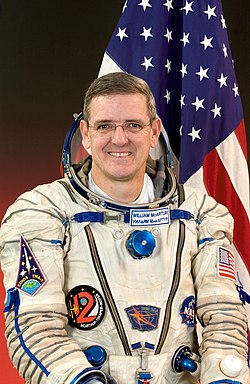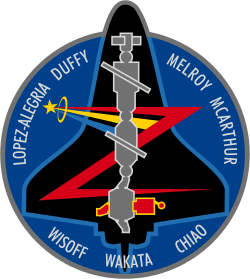William S. McArthur
| William Surles McArthur, Jr. | |
 William McArthur | |
| NASA Astronaut | |
|---|---|
| Tillstånd | Aktiv |
| Född | 26 juli 1951 |
| Andra yrken | Testpilot |
| Grad | Överste, US Army |
| Tid i rymden | 224d 22h 19m |
| Uppdrag | STS-58, STS-74, STS-92, Sojuz TMA-7, Expedition 12 |
| Uppdragsemblem | |
William Surles McArthur, född 26 juli 1951 i Laurinburg, North Carolina, är en amerikansk astronaut uttagen i astronautgrupp 13 den 17 januari 1990.
Rymdfärder
Källor
”Biographical Data” (på engelska) (PDF). NASA. september 2014. https://www.nasa.gov/wp-content/uploads/2017/07/mcarthur_william.pdf?emrc=f6967d. Läst 18 maj 2024.
Media som används på denna webbplats
Astronaut William S. McArthur, Jr., Expedition 12 commander and NASA Space Station science officer, attired in a Russian Sokol suit, pauses from a busy training schedule in Star City, Russia to pose for a portrait.
The Expedition 12 patch represents both mankind's permanent presence in space and future dreams of exploration. The International Space Station (ISS), featured prominently in the center, will continue to grow in its capability as a world-class laboratory and test bed for exploration. The vision of exploration is depicted by the moon and Mars. The star symbolizes mankind's destiny in space and is a tribute to the space explorers who have been lost in its pursuit. The Roman numeral XII in the background signifies the 12th expeditionary mission to the ISS.
STS-74 Mission Insignia
- The STS-74 crew patch depicts the orbiter Atlantis docked to the Russian Space Station Mir. The central focus is on the Russian-built docking module, drawn with shading to accentuate its pivotal importance to both STS-74 and the NASA-Mir Program. The rainbow across the horizon represents the Earth's atmosphere, the thin membrane protecting all nations, while the three flags across the bottom show those nations participating in STS-74: Russia, Canada, and the United States. The sunrise is symbolic of the dawn of a new era in NASA space flight , that of International Space Station construction.
Designed by the crew members, the STS-92 patch symbolizes the second mission to carry U.S.-built elements to the International Space Station (ISS) for assembly. The black silhouette of the Space Shuttle Discovery stands out against the deep blue background of space in low Earth orbit. In the foreground in gray is a profile view of the ISS as it appears when the shuttle and crew arrive, with the station consisting of the Unity node, its two pressurized mating adapters (PMA), the Zarya functional cargo block, the Zvezda service module, and the Progress cargo vehicle.
Following the shuttle's rendezvous and docking, the ISS configuration will be augmented by the two elements delivered by Discovery–the Z1 truss and PMA-3. These two elements, depicted in red, will be installed using the shuttle's robot arm and be connected to ISS during four spacewalks. The multi-national nature of both the STS-92 crew and the ISS are reflected in the multi-colored Astronaut Office symbol.
STS-58 Crew Insignia





